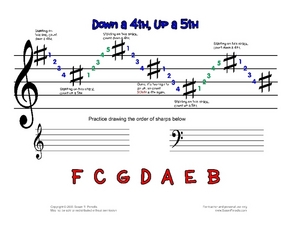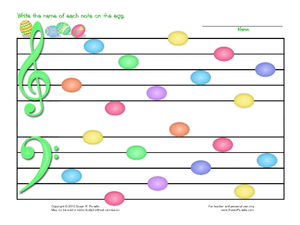Curated OER
Missing the Major Scales 2
Any musician can tell you, you have to know your scales, key signatures, and notes when reading sheet music. Kids are quizzed on major scales and the notes found with in each scale. They fill in the missing notes and identify each scale.
Curated OER
Simple Sharps
If you want to play music, you need to learn how to read sharps and flats. Young musicians practice reading and playing these simple sharps. Each sharp is given a word that connects it to the note it is related to. For example: Charles...
Curated OER
A Musical Accent Activity
Budding instrumentalists take on the task of reading accent marks and playing them correctly. They practice playing the provided rhythm or beat, focusing on emphasizing notes that have accents over them. The handout included provides...
Curated OER
Down a 4th, Up a 5th
It's time to practice those sharps. Young musicians write the order of sharps by counting down a fourth and up a fifth. This is a great way to teach sharps to emergent musical note readers.
Curated OER
Music Review Test
Wow this is a really thorough music quiz. There are a total of seven tasks for the class to complete. They must, write the C major scale, identify notes on the staff, write four major keys based on the information provided, identify...
Curated OER
Rhythm, Triads, Intervals
Let the class show what they know about rhythm, triads, and intervals with this quiz. They complete the rhythm on staff one and two, identify the intervals on staff three, and identify the triads on staff four. This is a well-thought-out...
Curated OER
Triads, Intervals, Keys, Note Values
Older or more advance musicians can test how well they can identify specific triads, intervals, keys, and note values with this quiz. Each staff focuses on one concept, they write the name of the triad, interval, or key.
Curated OER
Fearless Flats
This handout gives budding musicians an opportunity to practice placing and identifying notes and flats. A mnemonic is used to help them remember the names of each note as it appears on the staff.
Curated OER
Notes in the Fast Lane: Quiz
Here are four quizzes that cover note identification on the staff. Each page contains four sections, where the timed learners must identify and fill in the name of each note. These are titled as level 5, 6, 7, and 8, which implies that...
Curated OER
Triads - 7th Chords - Major/Minor Keys - Rhythm
Budding musicians transpose chords, identify major and minor keys, and complete measures to match the shown signatures. This resource can be used as a quiz, test, or as practice for those learning how to read and write music.
Curated OER
Using Harmonic Vision’s Music Ace Software to Reinforce Basic Music Skills
If you have access to Harmonic Vision’s Music Ace Software, then this instructional activity could work for you. Kindergarteners use the video music software to place, identify, and read musical notes. They listen in and identify both...
Curated OER
Graphic Scores
You can write some music scores using images rather than musical notation. Kids learn how they can become musical composers by using graphics or images in place of musical notation. An interesting slide-show, but a more interesting...
Curated OER
Easter Egg Musical Notes
Pastel Easter Eggs are all over this staff, and it's up to your young musicians to analyze each one. They write the name of the note in each egg to practice identifying notes while reading music.
Curated OER
Timed Note Identification
Before you can play from sheet music, you need to be able to read it. This timed quiz requires the class to identify as many of the 90 notes as they can. Notes are on a staff in both treble and bass clef.
Curated OER
Melodic and Harmonic Intervals
If you are teaching music and need a resource to demonstrate melodic and harmonic intervals, you're in luck. This hand out describes and shows what melodic and harmonic intervals look like on a staff.
Curated OER
Reading Basic Music Notes
First graders develop skills in reading music notes. In this reading music activity, 1st graders clap and chant rhythm patterns and learn music vocabulary. Students also match patterns by listening to the teacher perform the pattern.
Curated OER
Pitch Notation
A very basic introduction describes pitch notation. It shows the treble clef, describes notes as blobs with sticks, and provides an odd mnemonic to remember the positions of the notes of the staff. Note: This presentation was probably...
Curated OER
Instruments In Action
Students read and demonstrate eight measures of four beats. In this music reading lesson, students read and demonstrate through movement their mastery of eight measures of four beats. Students also classify instruments.
Curated OER
Music: The ABC's
In this music reading worksheet, learners study a diagram of the notes on a music staff and draw the 3 groups of notes on a blank staff included at the bottom of the worksheet.
Curated OER
Shaker Hymns in Beginning Band
Sixth graders are reminded of behaviors associated with playing music. They play various sections of a Shaker hymn using a slowed tempo with clarinets, trumpets, flutes, and baritones. They play together through key changes in other...
Curated OER
Bravo!!
Second graders study and experiment with rhythm and sound. In pairs, they practice reading and performing simple melodies from sheet music. Individually, they choose one piece to perform for the class.






















